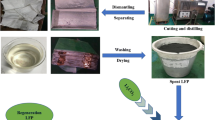Abstract
With the growing demand of print and copy in modern society, the number of abandoned toner cartridges has increased year by year. Unfortunately, the residual toner in abandoned toner cartridges is not all disposed properly and such unreasonable discard is serious damage to the environment and human health. Therefore, it is urgent and necessary to carefully dispose waste toner or even recycle them. In this work, waste toner is dealt with heat treatment (400, 600, and 800 °C) to obtain carbon-coated ferric oxides, which subsequently are investigated on the structures, morphologies, and electrochemical performances as active materials for lithium ion battery. In constant current charge and discharge measurements, the results show that the discharge-specific capacities of heat-treated ferric oxides reach to 966, 1029, and 1021 mAhg−1, respectively, in the first cycle. After 50th cycles, the discharge-specific capacity of the samples can, respectively, remain 288, 349, and 245 mAhg−1 in voltage range of 0.02–1.5 V, under the current density of 40 mAg−1, which demonstrates stable cycling performance and suggests potentiality of recycled waste toner as anode materials for lithium ion batteries.











Similar content being viewed by others
References
Leung A, Cai ZW, Wong MH (2006) Environmental contamination from electronic waste recycling at Guiyu, southeast China. J Mater Cycles Waste 8(1):21–33
Ilgin MA, Gupta SM (2010) Environmentally conscious manufacturing and product recovery (ECMPRO): a review of the state of the art. J Environ Manag 91(3):563–591
Robinson BH (2009) E-waste: an assessment of global production and environmental impacts. Sci Total Environ 408(2):183–191
Ruan J, Li J, Xu Z (2011) An environmental friendly recovery production line of waste toner cartridges. J Hazard Mater 185(2):696–702
Jujun R, Jia L, Zhenming X (2013) Improvements of the recovery line of waste toner cartridges on environmental and safety performances. Environ Sci Technol 47(12): 6457–6462.
Oliveira L, Messagie M, Rangaraju S, Sanfelix J, Rivas MH, Van Mierlo J (2015) Key issues of lithium-ion batteries - from resource depletion to environmental performance indicators. J Cleaner Prod 108:354–362
Badawy SM, Nayl AA, El Khashab R AEl-Khateeb MA (2014) Cobalt separation from waste mobile phone batteries using selective precipitation and chelating resin. J Mater Cycles Waste Manag 16:739–746
Zhang XH, Xie YB, Lin X, Li HT, Cao HB (2013) An overview on the processes and technologies for recycling cathodic active materials from spent lithium-ion batteries. J Mater Cycles Waste Manag 15:420–430
Wang X, Gaustad G, Babbitt CW (2016) Targeting high value metals in lithium-ion battery recycling via shredding and size-based separation. Waste Manag (Oxford) 51:204–213
Hanisch C, Loellhoeffel T, Diekmann J, Markley KJ, Haselrieder WKwade A (2015) Recycling of lithium-ion batteries: a novel method to separate coating and foil of electrodes. J Cleaner Prod 108:301–311
Wang MM, Zhang CC, Zhang FS (2016) An environmental benign process for cobalt and lithium recovery from spent lithium-ion batteries by mechanochemical approach. Waste Manag (Oxford) 51:239–244
Li J, Wang GX, Xu ZM (2016) Environmentally-friendly oxygen-free roasting/wet magnetic separation technology for in situ recycling cobalt, lithium carbonate and graphite from spent LiCoO2/graphite lithium batteries. J Hazard Mater 302:97–104
Sun L, Qiu KQ (2011) Vacuum pyrolysis and hydrometallurgical process for the recovery of valuable metals from spent lithium-ion batteries. J Hazard Mater 194:378–384
Ruan J, Xu Z (2011) A new model of repulsive force in eddy current separation for recovering waste toner cartridges. J Hazard Mater 192(1):307–313
Taisir S. Khedaywi (2014) Study on utilising waste toner in asphalt cement. Road Mater Pavement Des 15(2):446–454.
Patronov G, Tonchev D (2011) Waste toners and cartridges-utilization option. Sci Pap 38(5): 191–196.
Zeng Z, Zhao H, Wang J (2014) Nanostructured Fe3O4 @C as anode material for lithium-ion batteries. J Power Sources 248(7):15–21
Wang P, Gao M, Pan H (2013) A facile synthesis of Fe3O4/C composite with high cycle stability as anode material for lithium-ion batteries. J Power Sources 239(10):466–474
Ji L W, Lin Z, Alcoutlabi M, Zhang X W (2011) Recent developments in nanostructured anode materials for rechargeable lithium-ion batteries. Energy Environ Sci 4:2682–2699.
He CN, Wu S, Zhao NQ, Shi CS, Liu E, Li JJ (2013) Carbon-encapsulated Fe3O4 nanoparticles as a high-rate lithium ion battery anode material. ACS Nano 7(5):4459–4469
Victor AA, Luis Z, David F, Jahaziel V, Mataz A (2016) Composite nanofibers as advanced materials for Li-ion, Li–O2 and Li–S Batteries. Electrochim Acta 192:529–550
Hui W, Yi C (2012) Designing nanostructured Si anodes for high energy lithium ion batteries. Nano Today 7(5):414–429.
Zhao L, Gao M, Yue W (2015) Sandwich-structured graphene-Fe3O4@carbon nanocomposites for high-performance lithium-ion batteries. ACS Appl Mater Interfaces 7(18): 9709–9715.
Xiao W, Wang Z, Guo H (2013) Fe2O3 particles enwrapped by graphene with excellent cyclability and rate capability as anode materials for lithium ion batteries. Appl Surf Sci 266(2):148–154
Xiong QQ, Lu Y, Wang XL (2012) Improved electrochemical performance of porous Fe3O4/carbon core/shell nanorods as an anode for lithium-ion batteries. J Alloy Compd 536:219–225
Acknowledgements
This work was financially supported by the National Natural Science Foundation of China (51402185), Shanghai Municipal Natural Science Foundation (13ZR1454700), and the key subject of Shanghai Polytechnic University (Material Science and Engineering, XXKZD1601).
Author information
Authors and Affiliations
Corresponding author
Rights and permissions
About this article
Cite this article
Li, Y., Mao, J., Xie, H. et al. Heat-treatment recycling of waste toner and its applications in lithium ion batteries. J Mater Cycles Waste Manag 20, 361–368 (2018). https://doi.org/10.1007/s10163-017-0599-z
Received:
Accepted:
Published:
Issue Date:
DOI: https://doi.org/10.1007/s10163-017-0599-z




